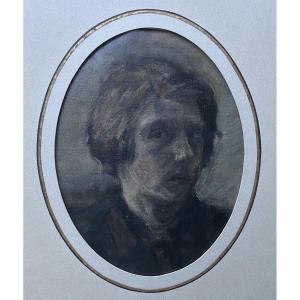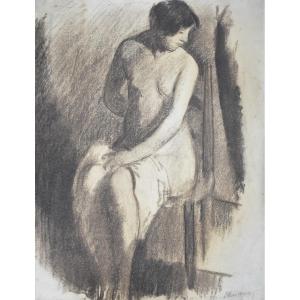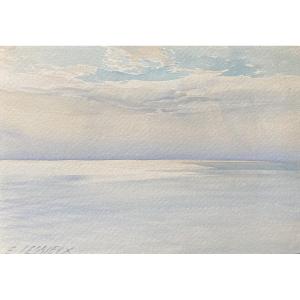Portrait of a young man,
oil on cardboard
45 x 36.5 cm
In good condition, except a few scratches visible in the top right-hand corner
Framed : 52 x 44 cm
Provenance : Estate and family of the artist.
It has just been suggested that the model could be a spahi, and more specifically a spahi from the 3rd spahi regiment.
He'd be recognizable by the red cape and white scarf characteristic of these colonial soldiers.
Raymond Woog was a French painter, draughtsman and illustrator who was born in Paris on 25 October 1875 and died in Neuilly-sur-Seine on 10 May 1949.
Raymond Woog studied with the symbolist painter Gustave Moreau at the École nationale supérieure des beaux-arts in Paris. In 1903, he was one of the exhibitors at the first Salon d'Automne, where he was noticed by the art critics Arsène Alexandre and Raymond Bouyer, the latter writing in La Revue Bleue on 14 November 1903: ‘There are twenty-six pupils of Gustave Moreau, all of them interesting, from the cameos of Paul Baignières to the travel notes of Raymond Woog ’. The two canvases he exhibited at the Cercle Volney in 1906 received a similar welcome: ‘The Portrait of Madame B. V. black and green, the intimacy with the pink morning, the blue cushion, the black and white petticoat, are energetic pieces, with a solid workmanship, a vigorous touch, very rich in colour, which reveal a true painter; the name Raymond Woog should be remembered,’ enthused Maurice Guillemot. The lithographic edition of his works soon made Woog one of the permanent artists at the Devambez gallery.
In 1912, following the death of Jules Comte, founder of the Revue de l'art ancien et moderne, Woog took over as provisional manager of the publication. This was interrupted in 1914, at the beginning of World War I. The following year, he was inducted, and spent six months in Flanders.
Upon being promoted to Lieutenant, he was posted as an attaché to the British Army. His sketches of English and French soldiers were published in 1916, as 32 plates in a canvas portfolio. It was a limited edition of 150 copies, with the title "Passed by Censor". He was mustered out early in 1918.
He began his career as an illustrator with a cover for the novel, Les Silences du colonel Bramble , by André Maurois, who also served with British troops during the war. Woog is said to have been the inspiration for the novel's narrator, "Aurelle", a French interpreter. This served as his entry into the milieu of the press, where he became a good friend of the journalist, Pierre Mille. He would soon be a recognized illustrator for several publications.
In 1928, he travelled to New York, for an exhibition of his works at the Jacques Seligmann gallery. Curiously, his reputation in the United States appears to have been based on his portraits of children. He did, in fact, perform several such commissions while there, but also painted portraits of notable people, such as Maurice Ravel.[ From 1933 to 1934, he was a regular collaborator with Les Nouvelles littéraires.
He made many long stays in Seine-et-Marne, where he specialized in painting flowers; a theme he would return to when he retired in 1940 and settled in Crest. He was named a Knight in the Legion of Honor in 1947.
His works are kept in a number of institutions and museums:
Berlin, French Embassy.
Vancouver, University of British Columbia, library,
Barcelona, Pablo Casals Foundation
Blois, Hôtel de Préfecture de Loir-et-Cher.
Le Havre, municipal archives
Paris : Ministry of National Education, Musée d'Art Moderne de la Ville de Paris, Carnavalet museum, Musée d'Orsay.
Roubaix, Musée de La Piscine.









































 Le Magazine de PROANTIC
Le Magazine de PROANTIC TRÉSORS Magazine
TRÉSORS Magazine Rivista Artiquariato
Rivista Artiquariato